3D movies have gained ridiculous ubiquity in the theater lately. Some movies tend to use the effect to a more pleasant degree than others, but I think most of us can agree that many movies don't need to be released in 3D. Some people get headaches or feel distracted by the over-use and exaggeration of the stereoscopic effects of these movies.
If you've watched a 3D movie, You've probably taken your glasses off in the middle, only to see a double-vision mess caused by being able to perceive both video channels at the same time with both eyes. Watching a movie this way is likely even more frustrating than enduring the side-effects of 3D.
Obviously, I'd suggest not seeing movies in 3D if you are prone to these side-effects, but perhaps your group of friends just HAS to see this movie in 3D, or maybe your schedule makes it more convenient to see a 3D showing. Here, I'll show you how to take two normal pairs of disposable RealD glasses and hack them so that your eyes only see one of the two video channels, effectively stripping the 3D effect from the big screen. The sad part: you still have to wear the stupid glasses.
There are several families of 3D video. RealD(tm) is currently the most commonly deployed 3D cinematic technology, and it uses something called circular polarization. Some of you might be familiar with polarized lenses used in sunglasses and camera filters. Those are usually linear polarizers. Linear polarizers are also used on LCD screens and have a number of other commercial applications. It would be possible to show movies with the left and right channels polarized linearly at right angles to one other, but this would force moviegoers to hold their head in such a way so that the lenses remained perfectly level, or else video brightness and channel separation would fall to pieces, although brightness always suffers a little when using polarized lenses.
Circular polarization works similarly, but the light is polarized in a helical fashion. This is a much more complicated process that solves several of the problems with linear polarization. One channel is polarized in a clockwise helix while the other channel is polarized counter-clockwise, allowing the lenses to filter out the other channel without being constrained the way linear polarizing lenses would as I mentioned above. The easiest ways to demonstrate this are to look through a pair of these disposable goggles and into a mirror, or look at one pair of 3D glasses through another pair. Apologies in advance for using crappy camera phone pictures for this. It's all I had on hand.

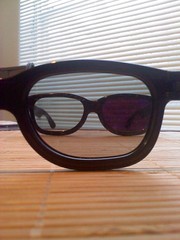
You would think all we have to do is take one of the lenses out and flip it over, so that both lenses only show the clockwise or counter-clockwise channel. I thought so too, but there seems to be more at play than I suspected and that won't work. Edit: each lens contains two filters bonded together, a polarizer and a "quarter wave plate", and flipping one lens over puts these filters in the improper order.
You'll have to tear into two pairs of 3D glasses, but the good news is that you can make two pair of 2D glasses out of them and give one to a friend. In a pinch, you could probably do all of this right there in the theater with nothing more than a simple Classic Swiss Army Knife. I'd recommend making these ahead of time, though.
If done correctly, this will get rid of most of the artifacts of stereoscopic cinematography, and hopefully relieve any side effects you might suffer.
RealD frames are snapped together in two pieces. With a small screwdriver, knife or other prying device, you can separate the inner part of the frame. We just need the lower part of one side of the frame to come apart far enough to slip the lens out.
Slide the lens out of the frame, being careful to not scrape it up.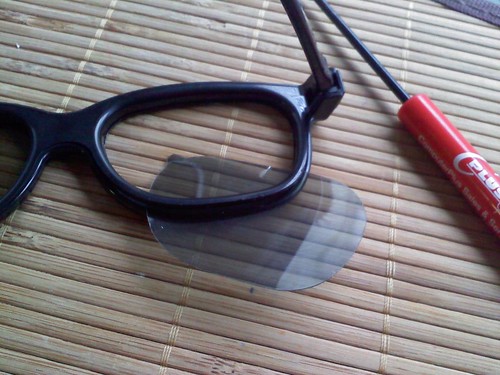
Perform the two above steps on the opposite lens of the second pair of glasses.
Using scissors, trim the thin lens material so that you can fit each lens into the "wrong" side of the other frame. Don't trim so much that it's prone to fall out of the frame, but trim enough that it won't bend or crease when you put it back into the frame.
Carefully slide the lens into the other frame, being sure it slides into the thin slot snugly. Remember, we're taking the left lens of one frame and putting it into the right side of another frame, and/or vise versa. You don't really need to put the second frame together if you only need one set of 2D glasses.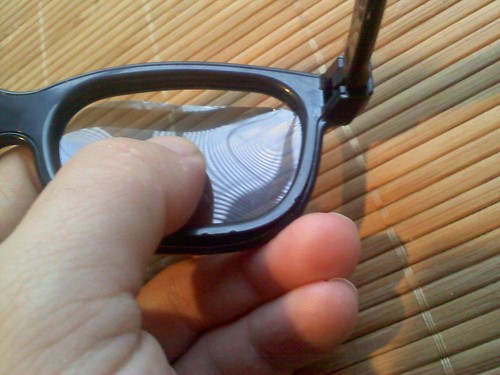
Snap the frames back together, then wipe the lenses clean, as they're sure to have fingerprints all over them.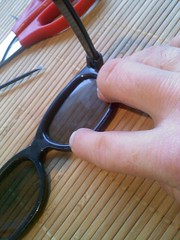
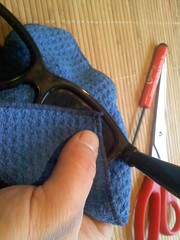
If you did it right, you should see that the movie looks the same through both eyes, and that looking at yourself in the mirror shows both dark lenses through both eyes, instead of just the lens you're looking through being dark.
2011-01-22
Building 2D Movie Glasses
Posted by
Ax0n
blog comments powered by Disqus
Subscribe to:
Post Comments (Atom)




